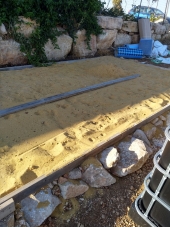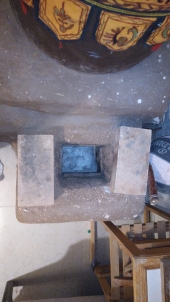I came across Rocket Mass Heaters in a Youtube video about seven years ago and I was immediately hooked. After several years of experimentation and a few prototypes in the middle of my living room (I really have no idea how my wife puts up with me), I eventually built one (with a lot of help from friends, family and the good folks here on Permies). This will be our fourth winter living with an RMH, but, the truth is that I am somewhat underwhelmed with the results and am looking for advice on how to improve. Don't get me wrong, I love my RMH, the kids love it, and the cob couch is our main living room couch. But, there is no denying that there are serious downsides:
1. I have a 6" system and the resulting feed is just too damn small. The wood I have available is often somewhat crooked, and is too thin to split easily and too big to use as-is. I spend way too much time splitting wood with a hand axe to get it to a size that is optimal for my stove.
2. Whether because I used dense firebrick, or because the burn tunnel is too long, or both, my system takes far too long to reach peak temperature. In the fall and spring this is tolerable, but in the dead of winter we usually need an additional source of heat to tide us over.
3. The peak temperature is just not as high as I expected it to be. I've never gotten anywhere near a visible red spot at the top of the barrel. I think the most I ever had it was around 300 degrees Celsius, and that happened only once and after running the heater for over three hours. At best it can keep a 30 sq.m living room warm, but it definitely doesn't reach the whole house (which isn't particularly large - 95 sq.m.)
Last year we just stopped using the RMH in the middle of winter because I was busy at work and I didn't have time to split wood and sit next to the stove maneuvering it through the feed. We are at the beginning of heating season and I need to improve the stove in a way that will require minimum effort and give maximum benefit. Here are the things I was thinking of, and I'd appreciate any additional ideas. Also, if my ideas suck I'd like to hear about it :-)
1. Rebuild the entire combustion area into a batch box style heater. This will supposedly solve all of my issues, but this is highly unlikely to happen right now. Winter is here and it will take me too long to design, gather supplies, and implement.
2. Remove the dense firebrick heat riser and insulation, and replace with ceramic fiber board. The ceramic fiberboard is fairly lightweight from what I saw in the specs, so I'm guessing it's insulative enough? This should actually be a fairly quick fix. Any reason not to do it? This would theoretically make the system burn hotter..
3. Enlarge the feed. I spoke to a local builder who suggested this is possible, although I couldn't find anything on it in the forums... He said I'd just have to make sure to not increase the amount of wood I put in, which is fine with me as long as I have more wiggle room for the same amount of fuel. Is this a good idea? Implementation would be fairly easy - I could just remove the first brick in the burn tunnel and the cob above it (see pic below). This would also have the additional benefit of decreasing burn tunnel length. If I could remove all of the bricks from the feed and just leave the cob, I'd have a very reasonably-sized feed.

I'd appreciate any feedback on my ideas above, and obviously any additional ideas are welcome too.
And now, for some grainy RMH porn:

Thanks guys!













